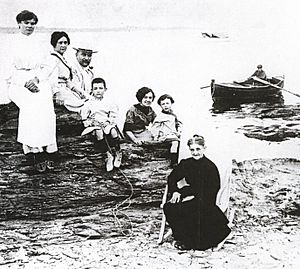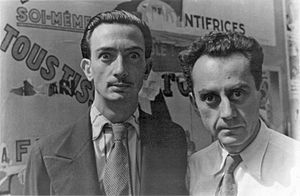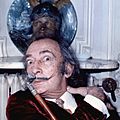Salvador Dalí facts for kids
Quick facts for kids
The Most Illustrious
Salvador Dalí, Marquess of Dalí of Púbol
|
|
|---|---|
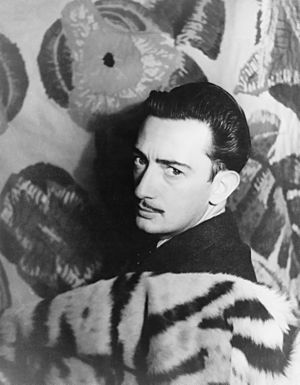
Dalí in 1939
|
|
| Born |
Salvador Domingo Felipe Jacinto Dalí i Domènech
May 11, 1904 |
| Died | January 23, 1989 (aged 84) |
| Resting place | Crypt at Dalí Theatre and Museum, Figueres |
| Education | San Fernando School of Fine Arts, Madrid, Spain |
| Known for | Painting, drawing, photography, sculpture, writing, film, and jewelry |
| Movement | Cubism, Dada, Surrealism |
| Spouse(s) |
Gala Dalí
(m. 1934; d. 1982) |
| Signature | |
Salvador Dalí (born May 11, 1904 – died January 23, 1989) was a famous Spanish Surrealist artist. He was born in Figueres, Catalonia, Spain. He studied fine arts in Madrid.
Dalí was first inspired by Impressionism and Renaissance artists. Later, he explored Cubism and other new art styles. By the late 1920s, he became a key figure in the Surrealism movement.
During the Spanish Civil War (1936-1939), Dalí lived in France. He then moved to the United States in 1940. He returned to Spain in 1948. Dalí shared his artistic ideas through many forms. These included painting, graphic arts, film, sculpture, and photography.
He also wrote fiction, poetry, and his autobiography. Dalí was known for his unusual behavior and public actions. Sometimes, these actions drew more attention than his amazing artwork.
Contents
About Salvador Dalí's Life
Salvador Dalí was born on May 11, 1904. His hometown was Figueres, Spain, near the French border. His father worked as a lawyer. Dalí's parents had another son, also named Salvador, who died before he was born. This idea of his lost brother stayed with Dalí. It even appeared in his later paintings. His sister, Anna Maria, was three years younger than him.
Dalí started art school when he was 12 years old. He discovered modern painting on a summer trip. This trip was to Cadaqués with the family of Ramon Pichot. The next year, Dalí's father showed his charcoal drawings at their home. His first public art show was in 1918. In 1921, the Pichot family introduced Dalí to Futurism. His uncle gave him books about Cubism and new art.
On February 6, 1921, Dalí's mother passed away from cancer. She had always supported his art. After her death, Dalí's father married his mother's sister. Dalí was fine with this marriage. He loved and respected his aunt very much.
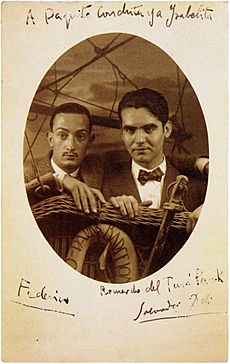
In 1922, Dalí began studying at the Real Academia de Bellas Artes de San Fernando in Madrid. He became good friends with Pepín Bello, Luis Buñuel, and Federico García Lorca. He also developed a deep love for the Prado Museum. He called it "the best museum of old paintings in the world." He spent much time studying the great masters there.
Dalí's Cubism paintings got a lot of attention. There were no other Cubist artists in Madrid then. His art stood out because he used so many different styles. He had his first solo show in Barcelona. This was before he learned about Surrealism. He had more shows after he started painting as a Surrealist in 1927.
Dalí's relationship with his father became difficult. Dalí lived with Gala, a Russian woman ten years older than him. His father did not approve of this. He also thought Dalí's connection to the Surrealists was a bad influence. Dalí and Gala rented a small fishing cabin. It was in a nearby bay at Port Lligat. He soon bought the cabin. Over the years, he bought neighboring cabins. He slowly built his beloved villa by the sea.
Dalí and Gala had lived together since 1929. They officially married on January 20, 1934, in Paris. Gala was his business manager and his inspiration. Dalí continued to paint her as they both grew older.
When World War II started, the Dalís left France. They sailed to the United States. They lived there for eight years. They split their time between New York and Monterey Peninsula, California. In 1941 and 1942, Dalí held art shows. He also published his autobiography, The Secret Life of Salvador Dalí. Dalí stayed busy during the rest of his time in the United States. He created art and designs for ballets. He also designed products like perfumes, cosmetics, hosiery, and ties.
In 1948, Dalí and Gala moved back to their house in Port Lligat. For the next thirty years, they spent most of their time there.
Dalí often used optical illusions in his art. He was one of the first artists to use holography in his work. In Dalí's later years, young artists like Andy Warhol said he greatly influenced pop art.
In 1960, Dalí started working on his Dalí Theatre and Museum. It was in his hometown of Figueres. This was his biggest project. It was a main focus of his energy until 1974, when it opened. He kept adding to it until the mid-1980s.
In 1968, Dalí bought a castle in Púbol for Gala. Starting in 1971, she would go there alone. She would not let him join her. Dalí became sad and his health began to decline. He had symptoms like Parkinson's disease. This included a severe tremor in his right arm.
Gala died on June 10, 1982. She was buried at Púbol. Dalí lived there for the next six years. On January 23, 1989, Dalí died at age 84. He is buried under the stage of his Theatre-Museum in Figueres. The Gala-Salvador Dalí Foundation now manages his official estate.
What Dalí's Art Means
Food and eating were very important in Dalí's thoughts and art. He connected food with beauty. He often used bread, eggs, and sea urchins in his paintings.
From the mid-1950s, Dalí started using rhinoceros and rhinoceros horn shapes in his art. He also used donkeys, ants, locusts, and elephants.
Dalí was always interested in science and math. This often showed up in his artwork. His famous soft watches might be about Einstein's theory of relativity. Images of atomic particles appeared in his work after the atomic bombing of Hiroshima and Nagasaki. Strands of DNA appeared in his art from the mid-1950s.
Dalí's Work Beyond Painting
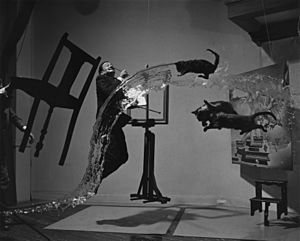
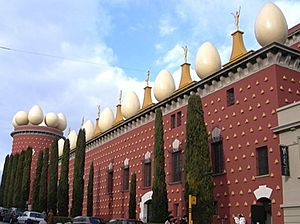
Dalí was a very creative artist. Some of his most popular works are sculptures and other objects. He is also remembered for his work in theater, fashion, jewelry, photography, literature, and architecture.
Dalí's Lasting Impact
Two main museums are dedicated to Dalí's art. One is the Dalí Theatre-Museum in Figueres, Spain. The other is the Salvador Dalí Museum in St. Petersburg, Florida, U.S..
Dalí's life and art have greatly influenced pop art. He also inspired other Surrealists. Modern artists like Jeff Koons and Damien Hirst have been influenced by him. Dalí has been played by actors in movies. These include Robert Pattinson in Little Ashes (2008) and Adrien Brody in Midnight in Paris (2011). Ben Kingsley played him in Daliland. The Salvador Dalí Desert in Bolivia and the Dalí crater on Mercury are named after him.
Awards and Honors for Dalí
- 1964: Knight Grand Cross of the Order of Isabella the Catholic
- 1972: Associate member of the Royal Academy of Science, Letters and Fine Arts of Belgium
- 1978: Associate member of the Académie des Beaux-Arts of the Institut de France
- 1981: Knight Grand Cross of the Order of Charles III
- 1982: Given the title 1st Marquess of Dalí of Púbol by King Juan Carlos
Places to See Dalí's Art
- Dalí Theatre-Museum – In Figueres, Catalonia, Spain. It has the largest collection of Dalí's work.
- Gala Dalí House-Museum – At the Castle of Púbol in Púbol, Catalonia, Spain.
- Museo Nacional Centro de Arte Reina Sofia (Reina Sofia Museum) – In Madrid, Spain. It has a large collection of his art.
- Salvador Dalí House Museum – In Port Lligat, Catalonia, Spain.
- Salvador Dalí Museum – In St Petersburg, Florida. It holds over 1500 of Dalí's works. This includes seven large "masterworks."
Famous Quotes by Salvador Dalí
- "Intelligence without ambition is a bird without wings."
- "Have no fear of perfection - you'll never reach it."
- "Drawing is the honesty of the art. There is no possibility of cheating. It is either good or bad."
- "The painter is not the one who is inspired, but the one who is able to inspire others."
Fun Facts About Salvador Dalí
- Dalí believed he was his dead brother, also named Salvador, reborn.
- He had a strong fear of grasshoppers.
- Dalí was kicked out of art school not once, but twice!
- He worked with Walt Disney on an animated film called Destino.
- He made good money as a commercial artist. He designed art and logos for big brands.
- Salvador Dalí had a pet ocelot named Babou.
- Dalí once gave a lecture wearing a diving suit and helmet.
- He also drove a Rolls-Royce Phantom II filled with cauliflower. This was on a road trip from Spain to Paris.
- Dalí’s upturned mustache is one of the most famous in art history.
- He designed a ruby heart that actually beats. It is called The Royal Heart.
- He wrote a cookbook, Les dîners de Gala. It had recipes for fancy dinners he hosted with Gala.
Images for kids
-
Portrait of Dalí by Allan Warren, 1972.
-
Church of Sant Pere in Figueres. This is where Dalí was baptized, had his first communion, and his funeral.
-
Dalí's crypt at the Dalí Theatre-Museum in Figueres. It shows his name and title.
-
Homage to Newton (1985). This bronze sculpture is in UOB Plaza, Singapore. It honors Isaac Newton. The open torso and heart mean "open-heartedness." The open head means "open-mindedness."
-
Gala in the Window (1933), Marbella.
-
Perseo (Perseus), Marbella.
Related pages
See also
 In Spanish: Salvador Dalí para niños
In Spanish: Salvador Dalí para niños
- List of Spanish artists
- Salvador Dalí and Dance


